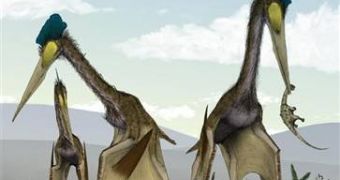You would think that with a reputation such as that of Tyrannosaurus rex even their youngsters would be at bay from predators. A new study now says that this was hardly the case, especially in the presence of flying reptiles such as Pterosaurs, a dinosaur living between 230 and 65 million years ago. Prior to the study, researchers envisioned Pterosaurs as preying on fish by skimming across the surface of water bodies, much in the same way gulls do today.
It now seems that Pterosaurs didn't really like to catch food while in flight, but would have rather hunted other smaller reptiles on land. This doesn't necessarily mean, however, that they did not fly.
"In our hypothesis, flight is primarily a locomotive method. They're just using it to get from point A to point B. We think the majority of their lives, when they're feeding and reproducing, that's all being done on the ground rather than in the air", said co-author Mark Witton of the University of Portsmouth.
Fossil analysis carried out alongside colleague Darren Naish on a Pterosaur species known as Azhdarchids, much larger than other Pterosaur species, some reaching weighs of 250 kilograms and wingspans of 10 meters, showed that more than 50 percent of the fossils were found in inland areas and that skeletal features seem to indicate that they could not have fed by skimming across the water surface.
"All the details of their anatomy, and the environment their fossils are found in, show that they made their living by walking around, reaching down to grab and pick up animals and other prey", said Naish.
Gulls for example, feed by dropping the lower jaw in the water until it hits a fish to raise it out of the water. "Regardless of what they hit, the impact force drives the head and neck underneath the body and into the water, thus requiring a hugely flexible neck", a feature that Pterosaurs clearly don't have, Witton said.
The Azhdarchid's stiff, long neck, however, appears perfectly adapted for feeding while using minimal neck action. Additionally, their feet are simply too small to support the theory that they might have fed by probing in soft mud. "Some of these animals are absolutely enormous. If you go wading out into this soft mud, and you weigh a quarter of a ton, and you've got these dinky little feet, you're going to just sink in", says Witton. Instead, its 3 meter long neck appears to be adapted for terrestrial prey, such as a Velociraptor or even a baby T-rex.

 14 DAY TRIAL //
14 DAY TRIAL //